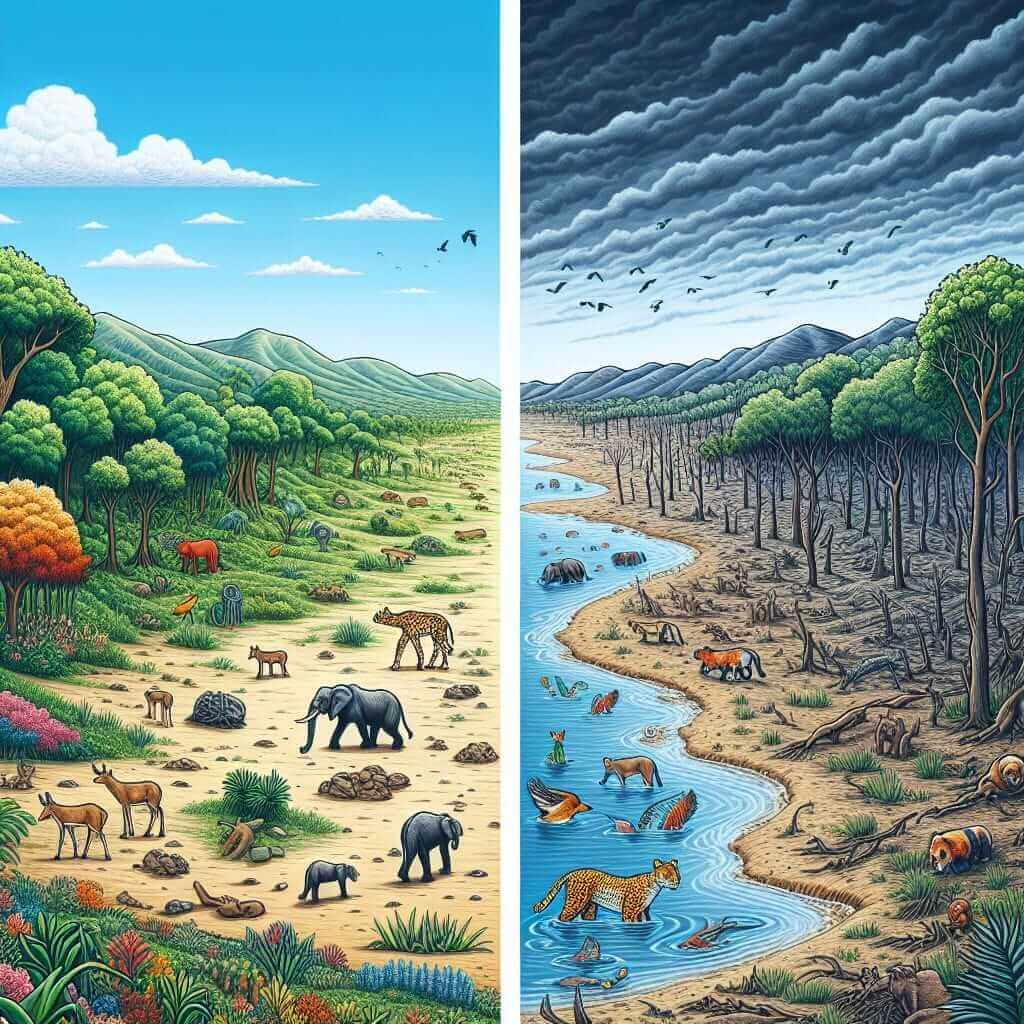Climate change is an increasingly pressing global issue with far-reaching consequences, particularly for the natural world. Understanding its impact on natural habitats is a topic frequently appearing in IELTS Writing Task 2, requiring test-takers to demonstrate their analytical and language skills. This article explores the connection between climate change and habitat disruption, providing valuable insights for crafting a compelling IELTS essay.
IELTS Writing Task 2 Sample Questions
Here are some potential IELTS Writing Task 2 questions related to “The impact of climate change on natural habitats”:
- Many argue that climate change is the biggest threat to natural habitats globally. To what extent do you agree or disagree?
- What are the main effects of climate change on natural habitats, and what measures can be taken to mitigate these impacts?
- Climate change is leading to the extinction of many species and the destruction of natural habitats. What are the potential consequences of this trend, and what can be done to reverse it?
Sample Essay Analysis
Let’s choose the following question for our sample essay:
Many argue that climate change is the biggest threat to natural habitats globally. To what extent do you agree or disagree?
Essay Analysis
This question requires you to present a clear stance on whether climate change is the biggest threat to natural habitats. This means you need to not only discuss the impact of climate change but also consider other potential threats (e.g., deforestation, pollution) and compare their severity.
Sample Essay
Climate change is widely acknowledged as a significant environmental challenge, and its impact on natural habitats is a subject of increasing concern. While some argue that it poses the most substantial threat to ecosystems globally, others maintain that other factors, such as deforestation and pollution, are equally or even more detrimental. This essay will argue that although climate change is a major concern, it is not the sole or necessarily the biggest threat to natural habitats, as other human activities often exacerbate its effects.
Undeniably, climate change has profound implications for ecosystems worldwide. Rising global temperatures can lead to habitat shifts, forcing species to migrate to cooler regions or face extinction. For instance, coral reefs, often dubbed the “rainforests of the sea,” are highly susceptible to even slight temperature increases, leading to coral bleaching and subsequent ecosystem collapse. Additionally, changes in precipitation patterns, including more frequent and severe droughts and floods, can disrupt delicate ecological balances, affecting both plant and animal life.
However, it is crucial to recognize that climate change often acts in concert with other anthropogenic pressures, magnifying their impact. Deforestation, driven by agricultural expansion and logging, not only removes vital habitat but also exacerbates climate change by releasing stored carbon into the atmosphere. Similarly, pollution from industrial activities and agricultural runoff can weaken ecosystems, making them more susceptible to the effects of climate change. For example, pollution can compromise the immune systems of marine organisms, making them more vulnerable to diseases exacerbated by warming waters.

In conclusion, while climate change is a significant driver of habitat loss and degradation, it is not the sole threat. Human activities such as deforestation and pollution often compound its effects, leading to more severe consequences for natural habitats. Therefore, addressing the multifaceted nature of environmental threats requires a holistic approach that tackles both climate change and other human-induced pressures on ecosystems.
Word Count: 298
Writing Tips
- Structure: Follow a clear essay structure with an introduction, body paragraphs presenting your arguments with supporting evidence, and a conclusion summarising your stance.
- Vocabulary: Use topic-specific vocabulary related to climate change, habitats, and environmental issues.
- Grammar: Pay attention to grammar accuracy, especially when using complex sentences to express your ideas effectively.
- Examples: Support your arguments with relevant examples to illustrate the impact of climate change on specific habitats or species.
Vocabulary
- Anthropogenic (adjective) – /ˌæn.θrə.pəˈdʒen.ɪk/ – Originating from human activity.
- Exacerbate (verb) – /ɪɡˈzæs.ə.beɪt/ – To make a problem, bad situation, or negative feeling worse.
- Delicate (adjective) – /ˈdel.ɪ.kət/ – Easily damaged or broken; fragile.
- Susceptible (adjective) – /səˈsep.tə.bl/ – Likely to be influenced or harmed by a particular thing.
- Compound (verb) – /kəmˈpaʊnd/ – To make a problem or difficult situation worse.
- Mitigation (noun) – /ˌmɪt.ɪˈɡeɪ.ʃən/ – The act of reducing the harmful effects of something.
- Biodiversity (noun) – /ˌbaɪ.oʊ.daɪˈvɝː.sə.t̬i/ – The variety of plant and animal life in the world or in a particular habitat.
- Ecosystem (noun) – /ˈiː.koʊˌsɪs.təm/ – A biological community of interacting organisms and their physical environment.
- Habitat loss (noun phrase) – The destruction or degradation of natural habitats.
- Climate change (noun phrase) – A long-term change in the average weather patterns that have come to define Earth’s local, regional and global climates.
Conclusion
This guide has provided an in-depth look at how to approach IELTS Writing Task 2 questions related to the impact of climate change on natural habitats. Remember to analyze the question carefully, structure your essay logically, and support your arguments with relevant examples and vocabulary. Continuous practice using the provided resources will undoubtedly equip you with the skills and knowledge to achieve a high band score.